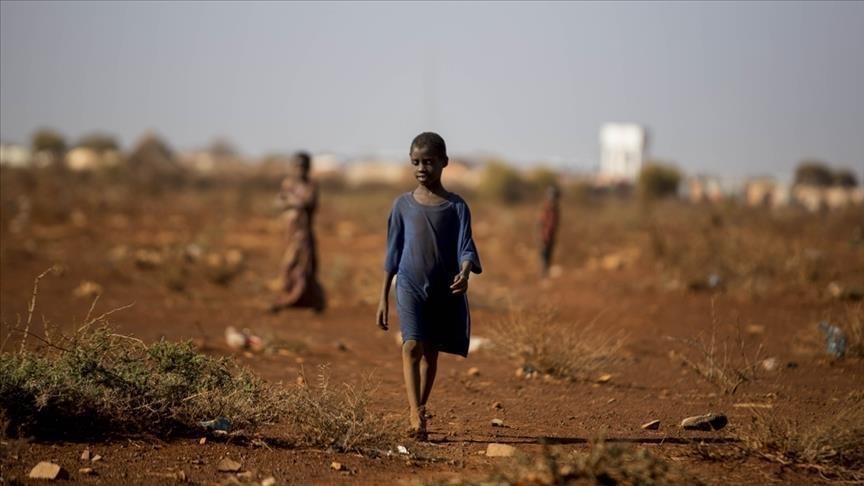

By Anadolu Agency
BAIDOA, Somalia
The South West state in Somalia is the most drought-affected region in the country and Baidoa, the state’s administrative capital, has seen an increase in the number of children affected by the prolonged drought that is the worst in a generation.
Hospitals and medical facilities in the city are overcrowded with children with severe acute malnutrition. Most are from low-income families and residents of internally displaced persons (IDP) camps in and on the outskirts of the city.
Garan Ibrahim Yerow, 20, is a mother of two children, who was sitting on a hospital bed with 2-year-old Maido Isack Mohamed who has been experiencing drought-related illnesses for two months.
She told Anadolu Agency at the SOS Children’s Villages Baidoa District Hospital that Maido is malnourished and she had to walk 6 kilometers (4 miles) to reach the hospital to get free treatment and health care services it provides.
“I started walking before sunrise to become the first parent to reach here. The doctors told me that my child is severely malnourished and too weak to carry and recommended to keep my child at the hospital for a week,” Yarow told Anadolu Agency emotionally.
Yarow and her husband had a small farm and livestock in a settlement 30 kilometers (18 miles) west of Baidoa. She fled because of the drought and built a small makeshift house at an IDP camp in Baidoa. She said that while she is at the hospital, her unemployed husband goes to town to find a job to try to feed her family.
She is not alone. Abdiyo Borow Osman, 24, a mother of four, has been visiting the hospital to get treatment for her child who was admitted because of malnutrition and health complications.
Her husband Abdirahman Mohamed said he cannot afford to go to a private hospital.
‘Situation is very bad’
“I don’t have any money and haven’t received assistance from the humanitarians since we arrived a few weeks ago,” Mohamed said. “I am trying to work hard but I cannot afford to feed my family every day. The worst situation I am having now is that my son is malnourished and he has also got swelling but I have a feeling that he will recover by the Grace of Allah.”
Hospital director Mohamed Daud Mohamed told Anadolu Agency that the number of children admitted in the last four months has increased.
He said his facility has admitted as many as 180 children with severe malnutrition, associated with medical complications.
“The situation is very bad as we have seen the number of malnutrition cases increase. Over six children who were severely malnourished died in this stabilization center because the people of rural areas always come when the situation of the children are on the verge of death,” said Mohamed.
Habibo Adan Ali, 17, has a baby girl named Ikhlas Abdullahi Adan who was admitted after her parents walked more than 30 kilometers. She is now stable but the latest illness with malnutrition took her to the limit.
Ali said she traveled to Baidoa and plans to permanently settle here after her child recovers. She said there is no reason to return because there is no medical facility in her village, Misgaale.
“A lot of people I know are in a bad situation and humanitarians can’t reach there because of the security so we made a decision that we will not go back to our village because I need medical help, humanitarian assistance and I believe we can get all that in this big town,” she said.
Drought-related illness have skyrocketed
Hassan Mohamed Ibrahim Gadudow, health and nutrition project coordinator for the SOS Children’s Villages, told Anadolu Agency that SOS and humanitarian partners have attended to more than 11,570 children with acute severe malnutrition and 15,494 acute moderate malnourished children – 48% of children in Baidoa.
He said drought-related illnesses have skyrocketed in the last few months.
“These illnesses include waterborne diseases such as cholera and also measles and other diseases. Children under 5, who are the most affected by malnutrition, are very vulnerable to falling ill since they are weak to resist due to the malnutrition,” he said.
More than 700 children have died in Somalia stabilization centers and medical centers due to drought-related illnesses and severe malnutrition, according to UNICEF.
The UN Food Security Integrated assessment indicated that an estimated 8.3 million people, more than half of the country, will face the crisis or worse food insecurity between April and June 2023.
A total of 1.8 million children, more than half of those in Somalia under the age of 5, are estimated to suffer acute malnutrition through July 2023.
More than 514,000 children are likely to face life-threatening severe malnutrition, according to the UN.
Forecasts between January to March 2023 in Somalia warn of a possible increase in the number of people facing acute food insecurity as the humanitarian situation has intensified live-saving assistance in the famine-projected area in the South West.
We use cookies on our website to give you a better experience, improve performance, and for analytics. For more information, please see our Cookie Policy By clicking “Accept” you agree to our use of cookies.
Read More